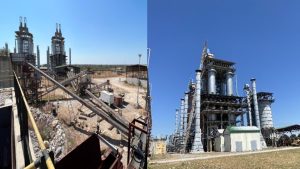Something subtle but consequential has shifted beneath the surface of global oil markets. Not through barrels moved or deals signed, but via a calculated policy signal that forces a reassessment of how far risk can travel when tension tightens without warning.
Iran’s recent decision to halt cooperation with international nuclear inspectors may not have directly disrupted the flow of crude, but its timing and implications have cast a fresh shadow over an already delicately poised energy market. With the announcement, inspections at Iran’s nuclear sites are now subject to internal political oversight, removing a layer of transparency just as geopolitical nerves had begun to settle.
Almost immediately, oil prices responded with a sharp move higher. Brent rose around 3% to reach over \$69 per barrel, while U.S. crude climbed in tandem, regaining ground lost during recent de-escalation across the Middle East. But this price movement was not about supply and demand in the classic sense. It was about recalibrating perceived risk, especially when set against a backdrop of tentative production increases and fragile diplomatic balancing acts.
For investors, the real significance lies not in the short-term price reaction but in what it signals about latent vulnerabilities. Market sentiment has proven highly sensitive to developments involving Iran, particularly given the proximity of key shipping routes and the country’s strategic positioning in regional power dynamics. Even without a drop in output, the fear of restricted flows through chokepoints like the Strait of Hormuz begins to seep back into pricing models.
At the same time, the data from U.S. inventories offers a counterweight. Stockpiles unexpectedly grew by nearly four million barrels, suggesting either muted domestic demand or supply resilience that continues to exceed expectations. This has placed traders in a state of tactical tension, balancing robust near-term fundamentals against the potential for a policy-driven disruption.
This comes just as OPEC+ prepares for another round of production adjustments. The group has been methodically increasing output month by month, with a planned rise of over 400,000 barrels per day anticipated. However, whether those increases are fully realised or tactically withheld remains uncertain. And now, with Iran’s stance introducing another variable, the timing and scale of future decisions may become more politically nuanced.
Beyond production and inventory figures, currency movement has also played a role. A marginally weaker dollar has helped support oil prices, though that impact remains modest compared to the influence of geopolitical developments. More material for investors is the question of positioning, how exposed portfolios are to further regional escalations and how risk is being priced across energy-linked assets.
From a strategic standpoint, this moment represents a tightening of the risk corridor. The market is not reacting to bombs or blockades, but to signals, measured, bureaucratic shifts that hint at broader intentions. If inspections remain paused and diplomatic routes become more entangled, the possibility of sanctions, retaliation, or even indirect disruptions to oil exports could emerge more sharply into focus.
There is also a latent question around spare capacity and how quickly producers can respond should tensions escalate further. With Saudi Arabia gradually increasing exports and broader OPEC+ capacity nearing historical limits, the margin for error is thin. Any policy shock that impacts availability could tighten supply-demand dynamics faster than the market can adjust.
This evolving situation underlines the need for investors to remain adaptive. The current environment rewards attentiveness to non-obvious signals and the ability to connect political decisions with market mechanics. Iran’s move may not yet be a turning point, but it is undeniably a pressure point, one that could mark the beginning of a broader recalibration in how the market discounts geopolitical friction.
Challenger Energy Group Plc (LON:CGE) is an Atlantic-margin focused energy company, with production, development, appraisal, and exploration assets in the region. Challenger Energy’s primary assets are located in Uruguay, where the Company holds two high impact offshore exploration licences, totalling 19,000km2 (gross) and is partnered with Chevron on the AREA-OFF 1 block. Challenger Energy is quoted on the AIM market of the London Stock Exchange.











































